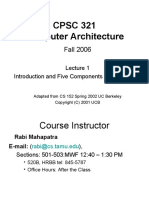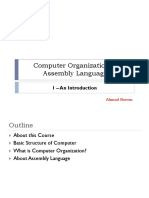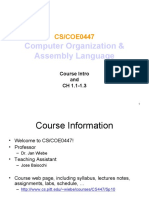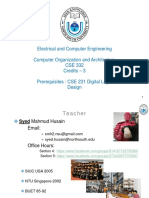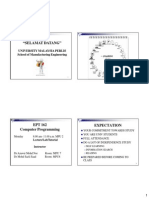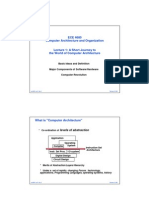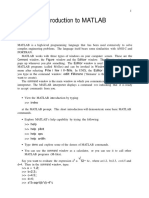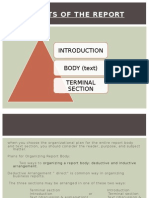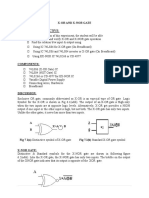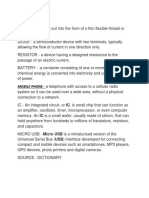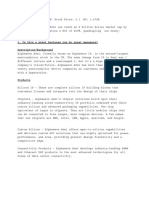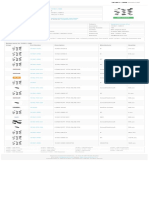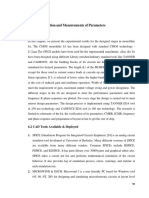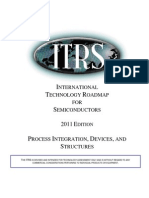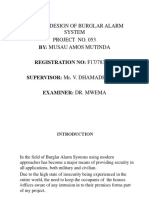EEE 343 Computer Organization
Adeel Israr
Adeel Israr | COMSATS Institute of Information Technology, Islamabad
�Consultation
Office:Room 214, EE Department
Email: adeel.israr@comsats.edu.pk
Consultation Hrs: Thru email or Any time I am not
busy and available in office
TA
Irfan Ullah
Lab Incharge
Khiyam Iftikhar
Adeel Israr | COMSATS Institute of Information Technology, Islamabad
�Books
Text Books:
Computer Organization & Design : The Hardware/Software
Interface By Patterson & Hennessy, Morgan & Kauffman Series
Reference Books:
MIPS Assembly Language Programming by Robert Britton
Computer Organization and Architecture, by William Stallings
Adeel Israr | COMSATS Institute of Information Technology, Islamabad
�Course Learning Outcomes
Towards the end of this course, you should be able to
Describe the instruction set architecture of a MIPS processor
Analyze, write, and test MIPS assembly language programs
Describe organization/operation of integer & floating-point units
Design the datapath and control of a single-cycle CPU
Design the datapath/control of a pipelined CPU & handle hazards
Describe the organization/operation of memory and caches
Analyze the performance of processors and caches
Required Background
Ability to program confidently in Java or C
Ability to design a combinational and sequential circuit
Adeel Israr | COMSATS Institute of Information Technology, Islamabad
�Rules for Attending my class
Be on time
Dont disturb the class under any
circumstances!
If you dont feel like studying or want to
attend to a call or anything else then get up
and leave quietly and then come and sit down
without asking me but dont disturb the class!
Adeel Israr | COMSATS Institute of Information Technology, Islamabad
�Rules for Attending my class
Assignment submission means on the
podium when I enter the class, any
time after that is considered a late
assignment.
Dont miss OHTs or the final exam
(Retests are usually twice as difficult)
Adeel Israr | COMSATS Institute of Information Technology, Islamabad
�Next . . .
Welcome to EEE 343
Components of a Computer System
High-Level, Assembly-, and Machine-Languages
Chip Manufacturing Process
Technology Improvements
Programmer's View of a Computer System
Adeel Israr | COMSATS Institute of Information Technology, Islamabad
�Components of a Computer System
Processor
Computer
Datapath
Memory
Control
Memory & Storage
Main Memory
Disk Storage
I/O Devices
Input
Control
Processor
B
U
S
Datapath
Output
Disk
Input devices
Output devices
Network
Bus: Interconnects processor to memory and I/O
Network: newly added component for communication
Adeel Israr | COMSATS Institute of Information Technology, Islamabad
�Opening the Box
Adeel Israr | COMSATS Institute of Information Technology, Islamabad
�Input Devices
Key Cap
Spring
Mechanical switch
Logical arrangement of keys
Adeel Israr | COMSATS Institute of Information Technology, Islamabad
Conductor-coated membrane
Contacts
Membrane switch
10
�Output Devices
Cleaning of
excess toner
Charging
Fusing of toner
Heater
Rotating
drum
Light from
optical
system
Rollers
Sheet of paper
Toner
Laser printing
Adeel Israr | COMSATS Institute of Information Technology, Islamabad
11
�Memory Devices
Volatile Memory Devices
RAM = Random Access Memory
DRAM = Dynamic RAM
1-Transistor cell + capacitor
Dense but slow, must be refreshed
Typical choice for main memory
SRAM: Static RAM
6-Transistor cell, faster but less dense than DRAM
Typical choice for cache memory
Non-Volatile Memory Devices
ROM = Read Only Memory
Flash Memory
Adeel Israr | COMSATS Institute of Information Technology, Islamabad
12
�Magnetic Disk Storage
A Magnetic disk consists of
a collection of platters
Provides a number of
recording surfaces
Read/write head
Actuator
Recording area
Arm provides read/write
heads for all surfaces
The disk heads are
connected together and
move in conjunction
Track 2
Track 1
Track 0
Arm
Direction of
rotation
Adeel Israr | COMSATS Institute of Information Technology, Islamabad
Platter
Spindle
13
�Magnetic Disk Storage
Disk Access Time =
Seek Time +
Rotation Latency +
Transfer Time
Read/write head
Sector
Actuator
Recording area
Track 2
Track 1
Seek Time: head movement to the
desired track (milliseconds)
Rotation Latency: disk rotation until
desired sector arrives under the head
Track 0
Arm
Direction of
rotation
Transfer Time: to transfer data
Adeel Israr | COMSATS Institute of Information Technology, Islamabad
Platter
Spindle
14
�Example on Disk Access Time
Given a magnetic disk with the following properties
Rotation speed = 5400 RPM (rotations per minute)
Average seek = 9 ms, Sector = 512 bytes, Track = 200 sectors
Calculate
Time of one rotation (in milliseconds)
Average time to access a block of 80 consecutive sectors
Answer
Rotations per second = 5400/60 = 90 RPS
Rotation time in milliseconds = 1000/90 = 11.1 ms
Average rotational latency = time of half rotation = 5.56 ms
Time to transfer 80 sectors = (80/200) * 11.1 = 4.44 ms
Average access time = 9 + 5.56 + 4.44 = 19 ms
Adeel Israr | COMSATS Institute of Information Technology, Islamabad
15
�Inside the Processor (CPU)
Datapath: part of a processor that executes instructions
Control: generates control signals for each instruction
Clock
Instruction
Cache
Instruction
Program Counter
Next Program
Counter
Registers
A
L
U
Data
Cache
Control
Adeel Israr | COMSATS Institute of Information Technology, Islamabad
16
�Datapath Components
Program Counter (PC)
Contains address of instruction to be fetched
Next Program Counter: computes address of next instruction
Instruction and Data Caches
Small and fast memory containing most recent instructions/data
Register File
General-purpose registers used for intermediate computations
ALU = Arithmetic and Logic Unit
Executes arithmetic and logic instructions
Buses
Used to wire and interconnect the various components
Adeel Israr | COMSATS Institute of Information Technology, Islamabad
17
�Infinite Cycle implemented in Hardware
Fetch - Execute Cycle
Instruction Fetch
Instruction Decode
Execute
Fetch instruction
Compute address of next instruction
Generate control signals for instruction
Read operands from registers
Compute result value
Memory Access
Read or write memory (load/store)
Writeback Result
Writeback result in a register
Adeel Israr | COMSATS Institute of Information Technology, Islamabad
18
�Clocking
Operation of digital hardware is governed by a clock
Clock period
Clock (cycles)
Data transfer
and computation
Update state
Clock period: duration of a clock cycle
e.g., 250 ps = 0.25 ns = 0.25 109 sec
Clock frequency (rate) = 1 / clock period
e.g., 1/ 0.25 109 sec = 4.0109 Hz = 4.0 GHz
Adeel Israr | COMSATS Institute of Information Technology, Islamabad
19
�Next . . .
Components of a Computer System
High-Level, Assembly-, and Machine-Languages
Chip Manufacturing Process
Technology Improvements
Programmer's View of a Computer System
Adeel Israr | COMSATS Institute of Information Technology, Islamabad
20
�Some Important Questions to Ask
What is Assembly Language?
What is Machine Language?
How is Assembly related to a high-level language?
Why Learn Assembly Language?
What is an Assembler, Linker, and Debugger?
Adeel Israr | COMSATS Institute of Information Technology, Islamabad
21
�A Hierarchy of Languages
Application Programs
High-Level Languages
Machine independent
High-Level Language
Machine specific
Low-Level Language
Assembly Language
Machine Language
Hardware
Adeel Israr | COMSATS Institute of Information Technology, Islamabad
22
�Assembly and Machine Language
Machine language
Native to a processor: executed directly by hardware
Instructions consist of binary code: 1s and 0s
Assembly language
Slightly higher-level language
Readability of instructions is better than machine language
One-to-one correspondence with machine language instructions
Assemblers translate assembly to machine code
Compilers translate high-level programs to machine code
Either directly, or
Indirectly via an assembler
Adeel Israr | COMSATS Institute of Information Technology, Islamabad
23
�Compiler and Assembler
Adeel Israr | COMSATS Institute of Information Technology, Islamabad
24
�Translating Languages
Program (C Language):
A statement in a high-level
language is translated
typically into several
machine-level instructions
swap(int v[], int k) {
int temp;
temp = v[k];
v[k] = v[k+1];
v[k+1] = temp;
}
Compiler
MIPS Assembly Language:
sll
add
lw
lw
sw
sw
jr
$2,$5, 2
$2,$4,$2
$15,0($2)
$16,4($2)
$16,0($2)
$15,4($2)
$31
MIPS Machine Language:
Assembler
Adeel Israr | COMSATS Institute of Information Technology, Islamabad
00051080
00821020
8C620000
8CF20004
ACF20000
AC620004
03E00008
25
�Advantages of High-Level
Languages
Program development is faster
High-level statements: fewer instructions to code
Program maintenance is easier
For the same above reasons
Programs are portable
Contain few machine-dependent details
Can be used with little or no modifications on different machines
Compiler translates to the target machine language
However, Assembly language programs are not portable
Adeel Israr | COMSATS Institute of Information Technology, Islamabad
26
�Why Learn Assembly Language?
Many reasons:
Accessibility to system hardware
Space and time efficiency
Writing a compiler for a high-level language
Accessibility to system hardware
Assembly Language is useful for implementing system software
Also useful for small embedded system applications
Space and Time efficiency
Understanding sources of program inefficiency
Tuning program performance
Writing compact code
Adeel Israr | COMSATS Institute of Information Technology, Islamabad
27
�Assembly Language Programming
Tools
Editor
Allows you to create and edit assembly language source files
Assembler
Converts assembly language programs into object files
Object files contain the machine instructions
Linker
Combines object files created by the assembler with link libraries
Produces a single executable program
Debugger
Allows you to trace the execution of a program
Allows you to view machine instructions, memory, and registers
Adeel Israr | COMSATS Institute of Information Technology, Islamabad
28
�Assemble and Link Process
Source
File
Assembler
Object
File
Source
File
Assembler
Object
File
Linker
Assembler
Object
File
Link
Libraries
Source
File
Executable
File
A program may consist of multiple source files
Assembler translates each source file separately into an object file
Linker links all object files together with link libraries
Adeel Israr | COMSATS Institute of Information Technology, Islamabad
29
�MARS Assembler and Simulator
Tool
Adeel Israr | COMSATS Institute of Information Technology, Islamabad
30
�Next . . .
Components of a Computer System
Assembly-, Machine-, and High-Level Languages
Chip Manufacturing Process
Technology Improvements
Programmer's View of a Computer System
Adeel Israr | COMSATS Institute of Information Technology, Islamabad
31
�Chip Manufacturing Process
Blank wafers
Silicon ingot
Slicer
8-12 in diameter
12-24 in long
20 to 40 processing steps
< 0.1 in thick
Tested dies
Die
Tester
Dicer
Packaged dies
Bond die to
package
Patterned wafer
Individual dies
Tested Packaged dies
Part
Tester
Adeel Israr | COMSATS Institute of Information Technology, Islamabad
Ship to
Customers
32
�Wafer of Pentium 4 Processors
8 inches (20 cm) in diameter
Die area is 250 mm2
About 16 mm per side
55 million transistors per die
0.18 m technology
Size of smallest transistor
Improved technology uses
0.13 m and 0.09 m
Dies per wafer = 169
When yield = 100%
Number is reduced after testing
Rounded dies at boundary are useless
Adeel Israr | COMSATS Institute of Information Technology, Islamabad
33
�Effect of Die Size on Yield
Good Die
Defective Die
120 dies, 109 good
26 dies, 15 good
Dramatic decrease in yield with larger dies
Yield = (Number of Good Dies) / (Total Number of Dies)
1
Yield =
(1 + (Defect per area Die area / 2))2
Die Cost = (Wafer Cost) / (Dies per Wafer Yield)
Adeel Israr | COMSATS Institute of Information Technology, Islamabad
34
�Inside a Multicore Processor Chip
AMD Barcelona: 4 Processor Cores
3 Levels of Caches
Adeel Israr | COMSATS Institute of Information Technology, Islamabad
35
�Next . . .
Components of a Computer System
Assembly-, Machine-, and High-Level Languages
Chip Manufacturing Process
Technology Improvements
Programmer's View of a Computer System
Adeel Israr | COMSATS Institute of Information Technology, Islamabad
36
�Technology Improvements
Year
Technology
1951
Vacuum tube
1965
Transistor
1975
Integrated circuit (IC)
1995
Very large scale IC (VLSI)
2005
Ultra large scale IC
Relative performance/cost
1
35
900
2,400,000
6,200,000,000
Processor transistor count: about 30% to 40% per year
Memory capacity: about 60% per year (4x every 3 years)
Disk capacity: about 60% per year
Opportunities for new applications
Better organizations and designs
Adeel Israr | COMSATS Institute of Information Technology, Islamabad
37
�Growth of Capacity per DRAM Chip
DRAM capacity quadrupled almost every 3 years
60% increase per year, for 20 years
Adeel Israr | COMSATS Institute of Information Technology, Islamabad
38
�Processor Performance
Slowed down
by power and
memory latency
Almost 10000x improvement
between 1978 and 2005
Adeel Israr | COMSATS Institute of Information Technology, Islamabad
39
�Classes of Computers
Desktop / Notebook Computers
General purpose, variety of software
Subject to cost/performance tradeoff
Server Computers
Network based
High capacity, performance, reliability
Range from small servers to building sized
Embedded Computers
Hidden as components of systems
Stringent power/performance/cost constraints
Adeel Israr | COMSATS Institute of Information Technology, Islamabad
40
�Computer Sales
Adeel Israr | COMSATS Institute of Information Technology, Islamabad
41
�Microprocessor Sales
ARM processor
sales exceeded Intel
IA-32 processors,
which came second
ARM processors
are used mostly in
cellular phones
Most processors
today are embedded
in cell phones, digital
TVs, video games,
and a variety of
consumer devices
Adeel Israr | COMSATS Institute of Information Technology, Islamabad
42
�Millions of Units
The Processor Market
Adeel Israr | COMSATS Institute of Information Technology, Islamabad
43
�Next . . .
Components of a Computer System
Assembly-, Machine-, and High-Level Languages
Chip Manufacturing Process
Technology Improvements
Programmer's View of a Computer System
Adeel Israr | COMSATS Institute of Information Technology, Islamabad
44
�Programmers View of a Computer
System
Software
Application Programs
High-Level Language
Level 5
Assembly Language
Level 4
Operating System
Interface
SW & HW
Level 3
Instruction Set
Architecture
Level 2
Microarchitecture
Level 1
Hardware
Physical Design
Adeel Israr | COMSATS Institute of Information Technology, Islamabad
Increased level
of abstraction
Level 0
Each level hides
the details of the
level below it
45
�Programmer's View 2
Application Programs (Level 5)
Written in high-level programming languages
Such as Java, C++, Pascal, Visual Basic . . .
Programs compile into assembly language level (Level 4)
Assembly Language (Level 4)
Instruction mnemonics are used
Have one-to-one correspondence to machine language
Calls functions written at the operating system level (Level 3)
Programs are translated into machine language (Level 2)
Operating System (Level 3)
Provides services to level 4 and 5 programs
Translated to run at the machine instruction level (Level 2)
Adeel Israr | COMSATS Institute of Information Technology, Islamabad
46
�Programmer's View 3
Instruction Set Architecture (Level 2)
Interface between software and hardware
Specifies how a processor functions
Machine instructions, registers, and memory are exposed
Machine language is executed by Level 1 (microarchitecture)
Microarchitecture (Level 1)
Controls the execution of machine instructions (Level 2)
Implemented by digital logic
Physical Design (Level 0)
Implements the microarchitecture
Physical layout of circuits on a chip
Adeel Israr | COMSATS Institute of Information Technology, Islamabad
47

